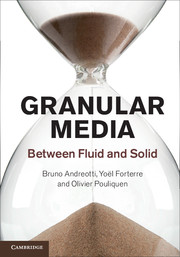2 - Interactions at the grain level
Published online by Cambridge University Press: 05 June 2013
Summary
The behaviour of a granular material is closely related to the nature of the interactions between grains. In this chapter, we focus on these forces at the grain level. We first discuss solid contact, which is dominant in the case of dry granular media made of macroscopic particles (Section 2.1). The basics of Hertz elastic contact, solid friction and the rules of inelastic collisions between solid particles are given. We then discuss other kinds of interaction between grains such as electrostatic and adhesive forces, capillary cohesion and solid bridges (Section 2.2). The last part of the chapter gives a brief overview of the hydrodynamic forces produced on a particle immersed in a fluid (Section 2.3). Our aim in this chapter is to provide some background in contact physics and hydrodynamics that will be useful for our study of granular media. More detailed treatments can be found in the classical books given in the text.
Solid contact forces
The contact force between two dry grains is usually split into a normal force and a tangential force. The physical origin of these forces at the microscopic level involves many phenomena, such as surface roughness, local mechanical properties (elasticity, plasticity, viscoelasticity) and physical and chemical properties (the presence of electrical charge, oxidation, temperature, the presence of lubricant film). In the following, we will not consider these microscopic features in detail but rather focus on the macroscopic laws of solid contact. At the macroscopic level, these laws are dominated by elastic repulsion (Hertz contact) and solid friction (Coulomb’s law).
- Type
- Chapter
- Information
- Granular MediaBetween Fluid and Solid, pp. 15 - 58Publisher: Cambridge University PressPrint publication year: 2013



